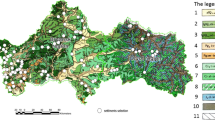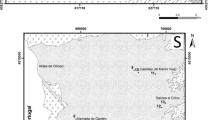Abstract—
Combined ecological and geochemical assessment was performed for the major- and trace-element composition of groundwater of Bryansk oblast used for drinking water supply, and settlements and districts were ranked with respect to the contents of I, Se, and some other chemical elements and their concentrations were compared with the existing hygienic standards. It was shown that the I and Se contents of drinking water is controlled by the geochemical conditions of water formation and do not reach physiological optimum levels (10 mg/L for I and 2.5–3.3 mg/L for Se) in most districts of the oblast, which could intensify the adverse response of the thyroid gland (TG) to the contamination of the region with I-131 during the Chernobyl nuclear accident of 1986. Furthermore, we revealed other unfavorable hydrochemical factors, which may influence the distribution of natural endemic diseases among local inhabitants related to local elevated concentrations of Mn (up to 10 MPC), Fe (up to 26 MPC), Si, and Sr (up to 2 MPC) in drinking waters confined to certain hydrogeologic complexes.




Similar content being viewed by others
REFERENCES
M. A. Antipov, E. A. Batova, A. E. Bakhur, N. A. Bezdenezhnykh, A. F. Bobkov, A. N. Borodin, T. S. Borodina, S. M. Vakulovsky, V. M. Vasil’ev, Ya. I. Gaziev, S. B. Gogol’, V. V. Gudzenko, S. V. Dadykin, Vikt. T. Dubinchuk, V. T. Dubinchuk, et al., “Assessment and Prediction of Water Quality Affected by the Chernobyl Accident (Bryansk Oblast) (1997–2001). A Final Report on Project RUS/95/004,” The Development Program of the United Nations Organization (DPUN), FSGiM OS., and MPR RF (Moscow), pp. 47–75.
Yu. G. Antonov, “Decisive role of iodine at endemic bronchocele and mobility of endemic areas,” Biological Role of Trace Elements, Their Application in Agriculture and Medcine), (vano-Frankovsk, 1978), Vol. 2, pp. 9–10.
Assessment and Prediction of Water Quality in Areas I-Mpacted by Chernobyl Accident (Bruansk Oblast, 1997–2001). A Final Report on the Project RUS/195/004 (Moscow, 2001) [in Russian].
E. Cardis, A. Kesminiene, V. Ivanov, I. Malakhova, Y. Shibata, V. Khrouch, V. Drozdovitch, E. Maceika, I. Zvonova, O. Vlassov, A. Bouville, G. Goulko, M. Hoshi, A. Abrosimov, J. Anoshko, et al., “Risk of thyroid cancer after exposure to 131I in childhood,” J. Natl. Cancer Inst. 97 (10), 724–732 (2005).
I. I. Dedov, O. N. Yudenich, G. A Gerasimov, and N. P. Smirnov, “Endemic goiter. Problems and Solutions,” Probl. Endokrinologii 38 (3), 6–15 (1992).
O. A. Denisova, N. V. Baranovskaya, L. P. Rikhvanov, G. E. Chernogoryuk, and E. V. Kalyanov, “Problems of thyroid pathology from the point of view of geoecology and geochemistry,” Razved Okhr. Nedr, No. 8, 60–63 (2011).
V. V. Ermakov, “Fluorimetric determination of selenium in the products of animal agriculture, organs (tissues) of animals, and environmental objects,” Methodical Recommendations on the Determination of Pesticides in Bilogical Objects (VASKHNIL, Moscow, 1987), pp. 8–18 [in Russian].
A. V. Ershov, I. I. Silin, Yu. S. Krivova, and T. I. Gubareva, “Anomalies of natural strontium in potable waters of the Kaluga oblast,” Vestn. Novykh Meditsin. Tekhnol. XIII (4), 161–165(2006).
R. Fuge, “Soils and iodine deficiency,” Essen. Med. Geol.: Impacts of the Natural Environment on Public Health (Burlington, MA: Elsevier, 2005), pp. 417–433
F. M. Fordyce, C. C. Johnson, U. R. B. Navaratna, J. D. Appleton, and S. B. Dissanayake, “Selenium and iodine in soil, rice and drinking water in relation to endemic goiter in Sri Lanka,” Sci. Total Environ. 263, 127–141 (2000).
A. Kabata-Pendias, and H. Pendias, Trace Elelements in Soils and Plants (CRC Press, Boca Raton, 1984).
N. V. Kanicheva, “Analysis of state of problems of the water supply system of people of the Bryansk Area,” Vestn. Bryansk. Sel’skokhoz. Akad., No. 6, 33–35 (2012).
V. K. Kashin, Biogeochemistry, Phytophysiology, and Agrochemistry of Iodine (Nauka, Leningrad, 1987) [in Russian].
L. I. Kolmykova, E. M. Korobova, N. V. Korsakova, V. Yu. Berezkin, V. N. Danilova, S. D. Shushvakhtova, and E M. Sedykh, “Assessment of iodine and selenium content in potable waters of the Bryansk oblast depending on the aquifers and conditions of migration,” Aktual. Probl. Ekol. Prirodopol’zov., No. 16, 140–143 (2014).
L. I. Kolmykova, E. M. Korobova, and B. N. Ryzhenko, “Content and distribution of iodine in natural waters of the Bryansk oblast,” Vestn. Tyumen. Gos. Univ. Ser. Ekol. Prirodopol’zov., 2 (1), 8–19 (2016).
V. G. Kondrat’ev, General Hygiene (Meditsina, Moscow, 1970) [in Russian].
E. M. Korobova, B. N. Ryzhenko, E. V. Cherkasova, E. M. Sedykh, N. V. Korsakova, V. N. Danilova, S. D. Khushvakhtova, and V. Yu. Berezkin, “Iodine and selenium speciation in natural waters and their concentrating at landscape–geochemical barriers,” Geochem. Int. 52 (6), 500–514 (2014).
V. V. Koval’skii and R. I. Blokhin, “Geochemical ecology of endemic goitre,” Tr. Biogeokhim. Lab. AN SSSR, No. 13, 191–216 (1974).
MUK 4.1.033-95. 4.1. Methods of Control. Chemical Factors. Determination of Selenium in Food. Methodical Recommendations.
L. P. Nikitina, V. N. Ivanova, and L. V. Anikina, “Selenium in rocks and soils,” Selenium in the Life of Man and Animals (VINITI RAN, Moscow, 1995), pp. 17–19 [in Russian].
A. D. Proshin and V. N. Doroshchenko, Iodine Deficiency of the Bryansk Oblast Population (OOO Ladomir, Bryansk, 2005) [in Russian].
G. F. Proskuryakova, “Two ways for increasing sensitivity by rhodanide–nitrite method of determination of trace amounts of iodine,” Agrokhimiya, No. 3, 14–16 (1974).
G. F. Proskuryakova, R. V. Shveikina, and O. V. Nikitina, “A method for iodine determination in soil, water, plants, milk, and blood,” Proc. 2nd All-Russian Symp. On Methods of Trace Element Determination in Natural Objects (Samarkand, 1973), pp. 43–44.
Resolution no. 2-1021 from February 24, 2000 on Statement of Regional Program “Providing of the Population of the Bryansk Oblast by the Pivotal Water” (with modifications at July 21, 2007). A. A. Reznikov, E. P. Mulikovskaya, and I. Yu. Sokolov, Methods of Analysis of Natural Waters (Nedra, Moscow, 1970) [in Russian].
SanPiN 2.1.4.1074-01. Potable water. Hygienic Requirements to the Water Quality in Centralized System of Water Supply. Quality Control.
SanPiN 2.1.4.1116-02. Potable Water, Hygienic Requirements to the Quality of Packed Water. Quality Control.
SanPiN 2.1.4.1175-02. Potable Water and Water Supply of Populated Sites. Hygienic Requirements to the Water Quality of Non-Centralized Water Supply. Sanitary Protection of Springs.
P. S. Savchenko, Methods of Chemical and Microbiological Analysis of Water (Kiev, 1961) [in Russian).
V. V. Shakhtarin, Extended Abstract of Doctoral Dissertation in Medicine (Obninsk, 2000) [in Russian].
A. V. Skal’nyi, Chemical Elements in Physiology and Ecolgy of Human (Moscow, 2004) [in Russian].
State Report “On the Environment State of the Bryansk Oblast in 2009. Committee on the Nature Management and Environment Protection, Licensing of Some Types of Activity in the Bryansk Area” (Bryansk, 2010) [in Russian].
State Report “On the Environment State of the Bryansk Oblast in 2011”, Committee on the Nature Management and Environment Protection, Licensing of Some Types of Activity in the Bryansk Area (Bryansk, 2012) [in Russian].
S. Yu. Sukhinina, G. I. Bondarev, and V. M. Pozdnyakovskii, “Iodine and its significance in human food,” Vopr. Pitaniya, No. 3, 12–15 (1995).
N. Yu. Sviridenko, Extended Abstract of Doctoral Dissertation in Medicine (Moscow, 1999) [in Russian].
E. S. Turetskaya and V. A. Danileichenko, “Iodine, bromine, cobalt, and copper in potable aters of mountanois area and endemic decease,” Trace Elements in Animal Agriculture and Medicine (Kiev, 1967), pp. 62–67 [in Russian].
I. Ya, Vasilenko, “Carcinogenic action of radioactive iodine isotopes,” Vopr. Onkologii, No. 6, 643–645 (1988).
A. P. Vinogradov, “Iodine in nature,” Priroda, No. 9, 670–678 (1927).
A. P. Vinogradov, Geochemical setting in the areas of endemic goiter,” Izv. Akad. Nauk SSSR. Ser. Geogr. Geofiz. 10 (4), 341–355 (1946).
ACKNOWLEDGMENTS
This study was partially supported by the Russian Foundation for Basic Research, project no. 13-05-00823.
Author information
Authors and Affiliations
Corresponding author
Additional information
Translated by A. Girnis
Rights and permissions
About this article
Cite this article
Kolmykova, L.I., Korobova, E.M., Gromyak, I.N. et al. Ecological and Geochemical Assessment of the Chemical Composition of Drinking Waters of Bryansk Oblast with Application to Increased Risk of Thyroid Gland Diseases. Geochem. Int. 58, 66–76 (2020). https://doi.org/10.1134/S0016702920010061
Received:
Revised:
Accepted:
Published:
Issue Date:
DOI: https://doi.org/10.1134/S0016702920010061




